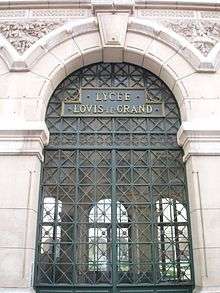Lycée Louis-le-Grand
The Lycée Louis-le-Grand (French pronunciation: [lise lwi lə gʁɑ̃]) is a prestigious secondary school located in Paris. Founded in 1563 by the Jesuits as the Collège de Clermont, it was renamed in King Louis XIV of France's honor after he extended his direct patronage to it in 1682. It offers both a sixth-form college curriculum (as a lycée or high school with 800 pupils), and a post-secondary-level curriculum (classes préparatoires with 900 students), preparing students for entrance to the elite Grandes écoles for research, such as the École normale supérieure (Paris), for engineering, such as the École Polytechnique, or for business, such as HEC Paris. Students at the Lycée Louis-le-Grand are called magnoludoviciens.
 Front entrance of the Lycée Louis-le-Grand, in Paris, one of the most famous lycées providing preparatory classes for grandes écoles | |
Former name | Collège de Clermont (1563–1682) |
|---|---|
| Type | local public Institution (EPLE) |
| Established | 1 October 1563 |
| Headmaster | Jean Bastianelli [1] |
| Students | 1,818 students in 2009 |
| Location | 123 rue Saint-Jacques, Paris , France 48.848056°N 2.344528°E |
| Medium of instruction | French |
| Website | www |

Louis-le-Grand, founded in 1563, is located in the heart of the Quartier Latin, the traditional student district of Paris. The lycée is situated opposite the Sorbonne and adjacent to the Collège de France. Its southern side opens onto the place du Panthéon, which is the location of its historical rival, the Lycée Henri-IV. These two lycées are home to the oldest preparatory classes in France, which are commonly viewed as the most selective in the country.
Because of this, Louis-le-Grand is considered to play an important role in the education of French elites. Many of its former pupils have become influential scientists, statesmen, diplomats, prelates, intellectuals and writers. "The Jesuit College of Paris", wrote Élie de Beaumont in 1862, "has for a long time been a state nursery, the most fertile in great men". Indeed, former students have included writers Molière, Victor Hugo and Charles Baudelaire, revolutionaries Maximilien Robespierre and Camille Desmoulins, as well as seven former presidents of the French Republic and countless other ministers and prime ministers, philosophers such as Voltaire, the Marquis de Sade, Denis Diderot, Emile Durkheim, Jean-Paul Sartre, Jean Cavaillès and Jacques Derrida, scientists Évariste Galois, Henri Poincaré and Laurent Schwartz, and artists Eugène Delacroix, Edgar Degas and Georges Méliès. Renowned foreign students of the lycée include King Nicholas I of Montenegro, Léopold Sédar Senghor, and Saint Francis de Sales.
Admission to Louis-Le-Grand is very competitive; the strict selection process is based on academic grades, drawing from middle schools (for entry into high school) and high schools (for entry into the preparatory classes) throughout France. Its educational standards are highly rated and the working conditions are considered optimal due to its demanding recruitment of teachers. Louis-Le-Grand students generally achieve excellent results; topping national rankings for baccalauréat grades in high school and entry into the best grandes écoles in the preparatory classes.
Abu Dhabi Section
In September 2008, LLG and the Abu Dhabi Education Council launched the Advanced Math and Science Pilot Class. There is a class designed for girls (20 girls) and another for boys (20 boys). Classes are taught by professors sent from France, and the classes are exceptionally taught in English.
The students who make up the Advanced Math and Science Pilot Class graduate at the end of the 12th grade and are awarded with a certificate of academic recognition by LLG. The final cohort of the program graduated in 2017 marking the end of the LLG-Abu Dhabi program[2]
Notable alumni
|
Writers, philosophers and social scientists
Artists and composers
|
Scientists
Statesmen and politicians
Other personalities
|
During World War II, student Jacques Lusseyran founded the resistance group Volontaires de la Liberté.[4] Sainte-Beuve refers to Louis-le-Grand as le collège des Jésuites à Paris.[5]
Courtyards
There are several courtyards at the school:
 Cour Victor Hugo
Cour Victor Hugo.jpg) Cour Victor Hugo
Cour Victor Hugo Cour Molière
Cour Molière Cour d'Honneur
Cour d'Honneur
See also
- Secondary education in France
- Education in France
References
- « Du lycée Montaigne à Louis-le-Grand », Sud-Ouest, 8 May 2012.
- "Archived copy" (PDF). Archived from the original (PDF) on 12 February 2016. Retrieved 25 February 2016.CS1 maint: archived copy as title (link)
- Historique du lycée par Paul Deheuvels, proviseur de 1969 à 1991 Archived 22 January 2015 at the Wayback Machine. Retrieved 30 March 2008.
- Hochard, Cécile. "Journal des Volontaires de la Liberté: Le Tigre". Musée de la Résistance et de la Déportation à Besançon. Retrieved 10 March 2014.
- Sainte-Beuve, "L'abbé de Bernis" (28 March 1852), Causeries du lundi, tome 8 (Paris: Garnier Frères, n.d. [1926]), p.3
External links
| Wikimedia Commons has media related to Lycée Louis-le-Grand. |
(These pages are in French)
- Lycée Louis-le-Grand (official website)
- http://www.fcpellg.fr/ (parents' association)
- http://peepllg.com (parents' association)
- https://www.louislegrand.net (online directory for students, alumni and teachers)